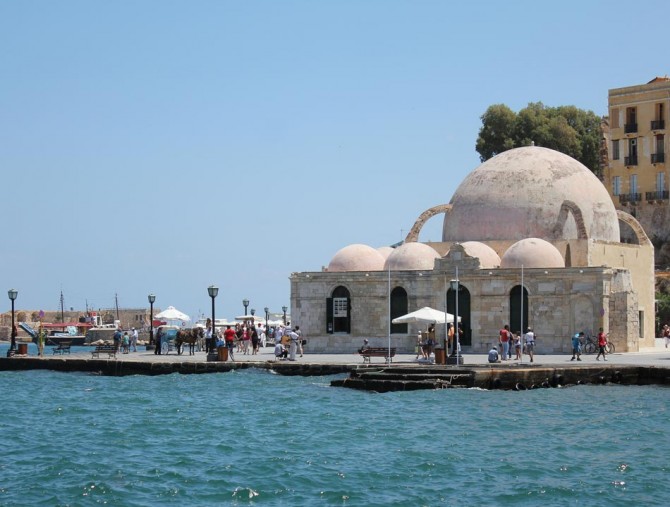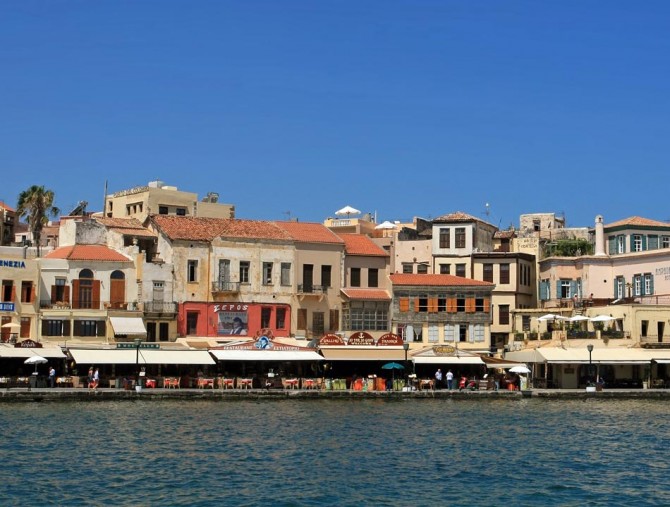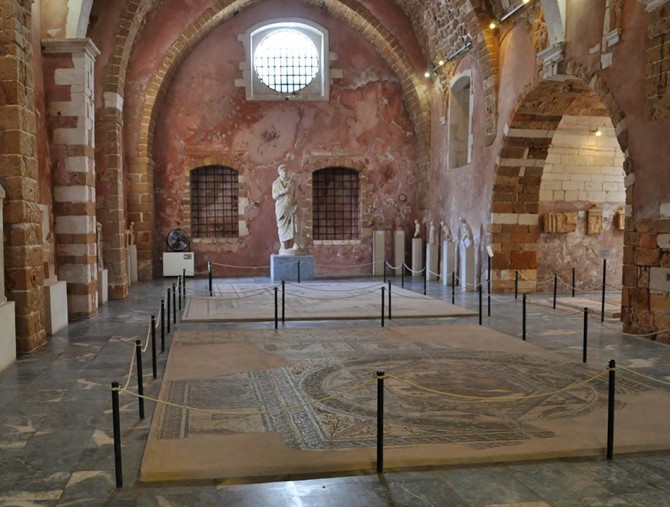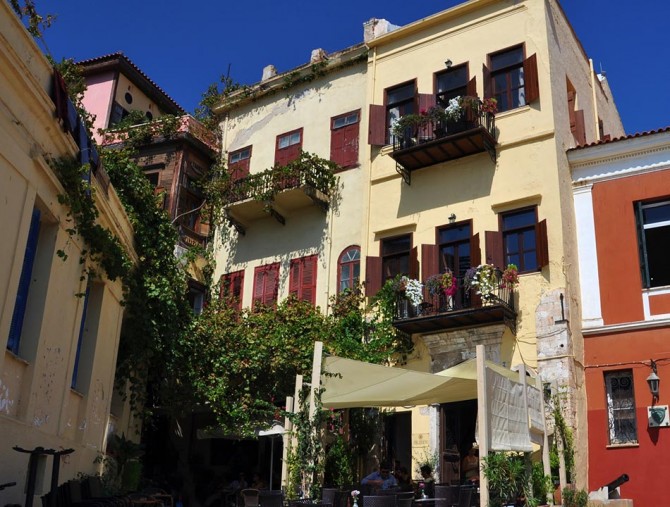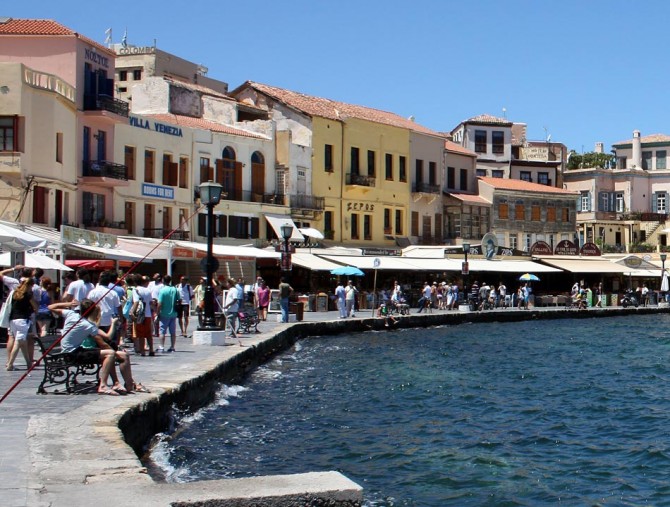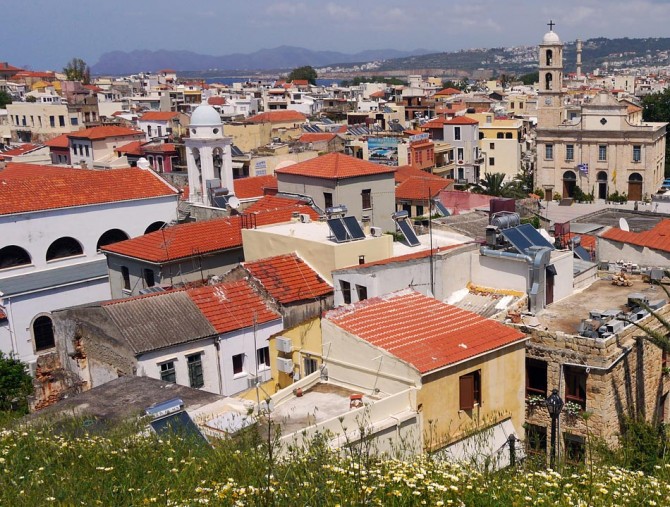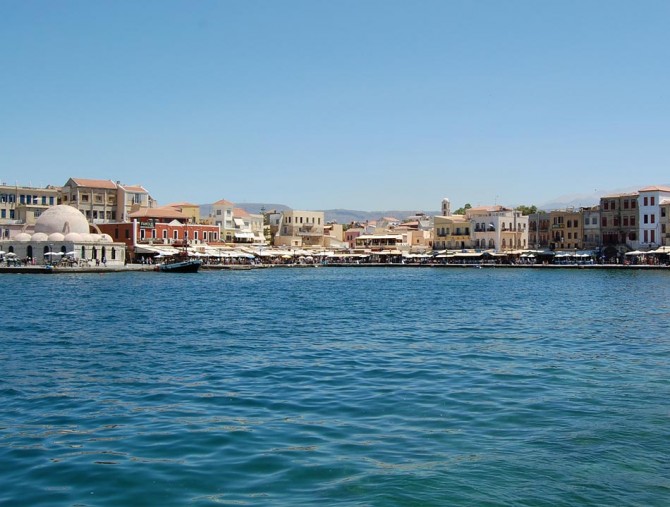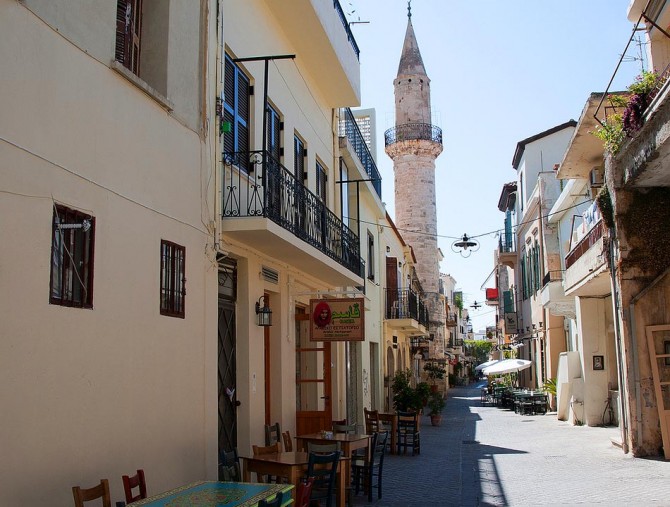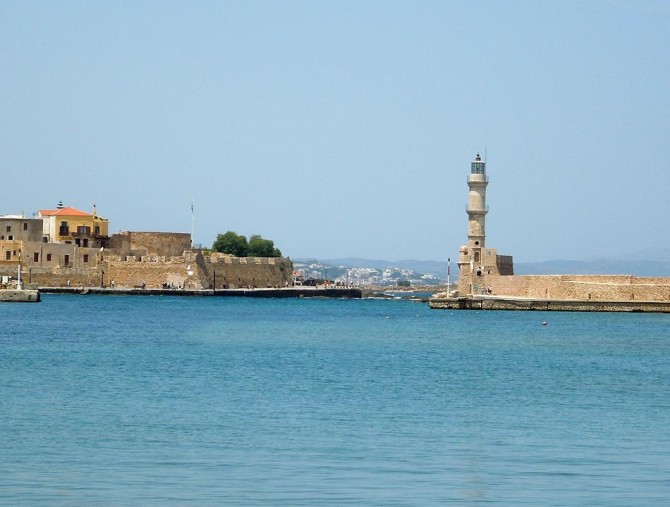Ханья
Византийская и последующая история Ханьи богата событиями. После Четвертого крестового похода Крит был выделен Бонифацию Монсфератскому. Он, в свою очередь, продал это владение венецианцам за 1000 серебряных марок. Венецианцы овладели островом в 1252 году, но в 1263 году их конкуренты из Генуи под предводительством графа Мальты Энрико Пескаторе и при поддержке местного населения выбили их с острова. Генуя удерживала власть над островом до возвращения венецианцев в 1285 году.
При венецианцах город Ханья стал резиденцией Ректора - главы администрации острова. Город был важным торговым центром процветающего сельскохозяйственного региона. Первоначально венецианское правление было строгим и репрессивным, но позднее отношение между критянами и венецианцами улучшились. Контакт с Венецией вел к тесному переплетению венецианской и критской культур, но греческое население, однако, сохраняло православное вероисповедание. Город назывался La Canea. Городские укрепления были усилены, и границы города приобрели современные очертания.
После падения Константинополя в 1453 году многие священники, монахи и художники нашли прибежище на Крите. В течение последующего периода в городе Ханья сложилась смесь византийской, венецианской и классической греческой культуры. В это время были построены многие важные здания, развивались письменная культура, музыка, образование
О тех временах осталось немало впечатляющих артефактов. В юго-западной части венецианского порта Ханьи сохранился впечатляющий форт Фирка, построенный в период между 1610 и 1645 годами. Его изначальное название было Ревелино дель Порто, однако во времена турецкого господства форт использовался как барак (по-турецки Фирка). Так крепость получила свое нынешнее название. В момент присоединения Крита к Греции в 1913 году именно на одной из башен крепости был впервые поднят греческий флаг. Сейчас тут располагается морской музей Крита. Часы работы 9:00-14:00 (зимой) и 9:00-19.:00 (летом). Еще одна значимая деталь венецианского порта - останки средневековых зданий верфи. Сейчас самый крупныое здание из них Мегало Арсенали, построенное в 1585 году, функционирует как Центр средиземноморской архитектуры. Часы работы 8:00-15:00.
Единственная сохранившаяся мечеть Ханьи также расположена в порту. Она называется Яли Джами и была построена в XVII веке. Сейчас оно полностью отреставрировано и используется как выставочное пространство. Также в порту можно увидеть старейший маяк в мире - Египетский маяк, построенный венецианцами в XVI веке. Своим названием он обязан египтянам, восстановившим его 200 лет спустя.
Несмотря на то, что большинство интересных зданий находятся в венецианском порту, масса достопримечательностей есть в других частях города. Например, это неоклассическое здание муниципального рынка, построенное в 1911 году. Этот рынок считается одним из самых крупных на Балканах. Он находится на площади Софоклиса Венезелоса. Не менее важная достопримечательность Ханьи - городской парк, расположенный на пересечении улиц Папандреу и Джанакаки. Он был разработан любителем Греции Реуф-Пашой в 1870 году. По тем временам парк соответствовал последним мировым технологиям. В наши дни - это любимое место отдыха жителей Ханьи. Восточная часть парка украшена внушительными часами, построенными в 1924 году, которые неприменно стоит увидеть.
Вокруг города находятся немало превосходных пляжей. Вот некоторые из них: Элафониси, Фаласарна, Балос, Сугия и Палеохора. Любителям природы должны прийтись по душе Ущелье Самария и пресноводное озеро Курнас. Также немало неподалеку от Ханьи и маленьких прекрасных островков с уютными пляжами. В их чисто входит Гавдос, на который можно попасть из Сфакии, которая, как утверждает легенда, никогда не была никем захвачена.
Как добраться до Ханьи:
- на пароме из порта Пирея до Суды (порта Ханьи), расположенного в 7 км от города. Путь составит порядка 10 часов. Паромы отплывают примерно в 21:00 и прибывают на Крит в 5:30
- на скоростном судне из порта Пирея. Путь составит 4,5 часа. Отправление в 16:30 и прибытие в 20:30.
- на самолете. Аэропорт Ханьи “Иоанис Даскалогианис” находится на полуострове в 14 км от города.
Τекст: Александр Фролов
Chania
The magical Venetian port is the best spot of Chania, a city that is so beautiful that you will enchant you instantly. It is the capital city of the prefecture of Chania, a Cretan region that is blessed with indescribable beauties and magical beaches. That means that although the city itself is a quite satisfactory reason to visit Chania, it’s also the surrounding places that makes this destination so special.
The modern city of Chania is the 7th largest Greek city and has nothing to envy from the other big cities of Greece. It has modern buildings, big squares, wide avenues, theaters and universities. If you expect to see a typical island city, you will feel disappointed. But when your foot reach the Old City, then you will travel in a dream. The old city of Chania is a jewel in the crown of Crete and extends around the old venetian port. Entire Venetians districts have been preserved untouched, while the port itself, that is surrounded by Venetians fortifications of 1538, is like cart-postal. No wonder that the heart of Chania’s nightlife beats in the old port, where dozens of bars and clubs are crowded along the picturesque coastal road.
Chania, to begin with, is built at the site of the ancient Kydonia, which was one of the three cities founded by the king Minoas (the founder of the amazing Minoan culture) and the third largest Cretan city in the antiquity. In the Castelli hill and the neighboring district of Splantza, the archaeologists found a seaside Early Minoan settlement, considered as the most important archaeological site of the west Crete (Castelli Hill, Old City of Chania. Visiting hours: 8:00-15:30. Free entrance). Being at Castelli, you can also visit the Byzantine wall that surrounds the hill. It was constructed in the 12th century and its outline is irregular with longitudinal axis from the East to the West, where there were the two central gates. The excavations revealed that this wall was built on the ruins of a previous ancient wall, dated in the 3rd century BC (Karaoli Dimitriou street, Old City of Chania).
About 15 km from Chania, over the bay of Souda, there are the remains of another significant Minoan city, known as Aptera. The city flourished in the 3rd and 4th century BC. The most impressive (in size and construction) of the surviving ancient buildings are the bands of Roman tanks, along with numerous wells and cisterns that served the city’s needs. Many centuries later, the Byzantines picked the center of the ancient city to built the imposing Monastery of St. John (in 1181 AD), which belonged to the Monastery of Patmos and operated until the mid-1960s (Souda, Aptera, Prefecture of Chania. Free entrance).
In the southwest side of the Venetian port of Chania, there is the impressive Fortress Firka, built by the Venetians between 1610 and 1645. Its initial name was Revellino del Porto, but during the Turkish occupancy, the fortress had been used as barrack (Firka in Turkish). When Crete was annexed to the liberated Greece, the Greek flag was raised on the angular turret of the fortress, in December 1, 1913. Besides the Firka itself, you can also visit the Naval Museum of Crete which is situated at the entrance of the fortress (Kountourioti Coast, Venetian port of Chania. Visiting hours: From November 1 to March 31, 9:00-14:00. From April 1 to October 31, 9:00-19:00).
The Venetian port of Chania is also adorned by the Venetians shipyards (known as arsenali), where the Venetians repaired the ships of their fleet during winter. The most impressive of them is the Megalo Arsenali, the last building of the complex of the shipyards towards the west. Its construction began in 1585, but a new floor was added in 1872, during the Turkish occupancy. After its restoration, it operates as the Centre for Mediterranean Architecture since 2002, hosting important Greek and international events in its premises (Defkalionos street, Venetian Port of Chania. Visiting hours: 8:00-15:00).
The only surviving Turkish mosque in the city of Chania is also located in the Venetian Port. It is the Yali Tzamisi (Mosque of Glass), was built in the 17th century and is a real jewel of Islamic Art in Renaissance. Today, the monument has been restored completely and operates as a forum for exhibitions and events during the summer season especially, becoming one of the most distinctive buildings of the old port of Chania. (Tompazi Coast, Venetian Port of Chania).
As it seems the most sightseeings of Chania are located in its wonderful Venetian port. One of them is the Egyptian Lighthouse, one of the oldest lighthouses in the world and one of the trademarks of the port as well. It was built by the Venetians in the end of the 16th century, but was rebuilt by the Egyptians about 200 years later, hence the current name.
Since Chania is not only the Venetian port, do not miss to visit the Municial Market, the Municipal Park and the Venizelos’ Tomps. The Municipal Market, to begin with, is a wonderful neoclassical building of 1911 in the center of the city. Apart from it architectural interest, it houses numerous shops selling local products and souvenirs, making it one of the biggest municipal markets in Balkans (Sofoklis Venizelos square, Chania). The Municipal Park is located in the junction of the streets Andreas Papandreou and Tzanakaki. It is the work of the philhellene Reouf Pasha. It was designed in 1870 according to the European standards and was planted with many evergreen trees and plants. It is the ideal place for walk and recreation and one of the most popular places of the city, especially during the summer, since it hosts the Municipal Summer Cinema. The east corner of the park is adorned by an impressive Clock, that was built in 1924 and is another of
the many sightseeings of Chania. As for the Venizelos’ Tomps, they are located a few kilometers east of the city, on the road to Akrotiri and the airport. This is the place where two very significant Greek figures are buried: Eleftherios Venizelos, the great Greek politician who served 7 times as Prime Minister , and his son, Sofoklis Venizelos, who was also Prime Minister of Greece. The view from this place is breathtaking and definitely worth the visit. At the same site you will also find the picturesque chapel of Prophet Elias (Profitis Elias of Akrotiri, Prefecture of Chania).
As we already said, Chania is also famous for its surrounding beauties. So, after you finish visiting this lovely city, it is time for you to rent a car (if you do not have one already) and start the touring in the prefecture. For swimming, you should definitely visit Elafonisi, Falasarna, Balos, Sougia and Palaiochora (that are the most famous and beautiful among the many other amazing beaches of the region). For the nature lovers, there is the absolutely fabulous Samaria Gorge, which is worldwide recognized and it would be a shame not to visit it, and the lake Kournas, the only natural freshwater lake in Crete, with unique variety of flora and fauna and breathtaking scenery. You can also swim in its waters and feel the magic.
If you want to feel the brave spirit of the Cretans and meet the most original Cretan area then do not miss to visit Sfakia, one of the few Greek places that have never been occupied. You can go there by bus from Chania. From Sfakia, you can also take a boat and sail till Gavdos, the southernmost Greek island, washed by the Lybian Sea. It also belongs to the prefecture of Chania and is a very beautiful island, especially designed for the people who love the quiet vacations.
The list with the sightseeings around Chania is endless. What you can do is to book a ticket to Chania and make sure that you have enough time to visit the region. It will a trip to remember!
How to get there: By ship: From Piraeus (and other Greek ports) to Souda, the port of Chania, 7 km east of the city. The trip from and to Piraeus lasts about 10 hours. The ships depart in the evening (9 pm) and arrive early in the morning (5:30 am), but during the summer months there also boats that depart in the morning. You can also take the super fast ferries and arrive to Souda in about 4,5 hours (departure at 4:30 pm and arriving at 8:30 pm). By air: From the other cities of Greece and abroad. The Chania’s airport “Ioannis Daskalogiannis” is located in Akrotiri peninsula, 14 kilometers east of the city and is connected to it by bus and taxi.
Τext: Marilou Pantazi

